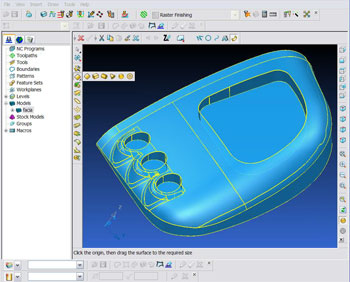Delcam Introduces Integrated Data Repair Module For Shop-Floor CAM Users
 Delcam has introduced a fully-integrated data repair module for its PowerMILL CAM system that will allow users to correct all the common faults with CAD data sent for machining. PowerMILL Modelling operates within the normal PowerMILL window, with a similar left-to-right workflow and style of icons making it easy for casual users to learn and operate.
Delcam has introduced a fully-integrated data repair module for its PowerMILL CAM system that will allow users to correct all the common faults with CAD data sent for machining. PowerMILL Modelling operates within the normal PowerMILL window, with a similar left-to-right workflow and style of icons making it easy for casual users to learn and operate.
"The concept of a CAM module that opens within a CAD package is well established, as are the benefits of providing CAM tools for CAD users in a familiar environment," explained Delcam's PowerMILL Product Marketing Manager, Mark Forth. "It seemed an obvious development to use a similar approach to provide, within PowerMILL, the modelling tools needed by CAM operators, especially those working on the shop floor."
PowerMILL Modelling offers two main benefits. Firstly, because the module is focussed on data repair rather than on product design, there are many fewer commands for the user to learn. This means that the time needed for training is shorter and that the casual user can find the options he needs more quickly.
Secondly, being able to undertake model repair on the shop floor means that any problems can be fixed by the CAM operator. This limits delays that would inevitably occur if the data had to be sent back to staff in the CAD office, as well as minimising the interruptions to their design work.
PowerMILL Modelling contains tools to identify and correct all the most common problems with imported data, including duplicate, missing or overlapping surfaces, incorrect surface trimming and gaps between surfaces. Similarly, design features that may cause problems in manufacturing can be modified, such as insufficient draft angles that could make it difficult to remove a part from its tooling or small fillets that might extend cycle times by restricting material flow.
The module can also be used to sketch boundaries within the model to limit individual machining strategies to particular areas of the part. For example, a mould tool could be divided so that a different material allowance could be left on the cavity surfaces and the parting surfaces.
A limited number of surface creation tools are also included. These can be used to generate the extra geometry needed for machining, for example, to create extension surfaces to control the movement of the tool away from the area being machined and to produce reference surfaces for five-axis programming.
SOURCE: Delcam Plc
